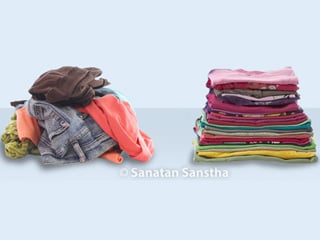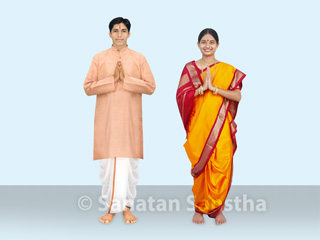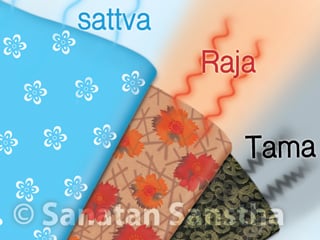Clothing around the world varies to a great extent. The choice of clothes depends on various cultural, environmental factors as well as personal choices. From a spiritual perspective, different types of clothes emit various kind of waves. Some of them have the ability to impart protection against negative energies. Let us find out through this article, the various types of clothes and their effect on people.
1. Non-artificial clothes
A. Valkal
Clothes made from the bark of a tree are called valkal. The Ramayan mentions that Shriram, His wife Seeta and brother Lakshman discarded royal clothes and wore valkal when they set out to dwell in the forest.
B. Clothes made from natural fibres
(such as cotton, khadi [Hand-woven cotton cloth], silk and wool)
1. Importance
A. Cotton and silk being natural fibres, their contact is conducive for healthy skin.- God (Through the medium of Ms. Madhura Bhosale, 6th November 2007, 2.30 p.m.)
B. Since cotton and silk are natural fibres, clothes made from them have greater ability to attract Divine Principle. Hence, an individual who wears such clothes attains more benefit of the Divine Principle. – An Unknown Energy (Through the medium of Ms. Ranjana Gawas, Phalgun Krushna Dwitiya, KaliyugVarsh 5110, 25th March 2008, 3.50 a.m.)
C. When compared with clothes made from artificial fibres, clothes made from natural fibres have greater ability to imbibe and retain sattvik vibrations. Hence, they are less susceptible to the attacks of negative energies. That is why; natural clothes remain pure and Holy for a longer period.
2. Cotton clothes
A. Cotton clothes immediately absorb sweat from the skin, thus preventing it from becoming sticky; also, the skin remains healthy and lustrous.’ – God (Through the medium of Ms. Madhura Bhosale, 6th November 2007, 2.30 p.m.)
B. The Nirgun (Non-materialized) Divine waves are imbibed in the cotton on the plant. Hence, wearing cotton clothes gives a comfortable feeling and increases the sattvikta of the wearer. – An Unknown Energy (Through the medium of Ms. Ranjana Gawas, Phalgun Krushna Dwitiya, KaliyugVarsh 5110, 25th March 2008, 3.50 a.m.)
C. Spiritual experiences related to the fact that cotton clothes have greater ability to resist attacks of negative energies.
On 25th June 2006 in one of the rooms of the Ashram , ants had gathered on a rope on which washed clothes were hung for drying. An army of ants was seen on the synthetic clothes, whereas on the cotton clothes there were hardly one or two ants. Cotton is a natural fibre and has more of the Divine Principle, the emission of which resisted attack of ants; hence, there were just one or two ants on cotton clothes. This happened for two successive days. Then I realized the importance of cotton clothes.’ – Ms. Ranjana Gawas, Sanatan Ashram, Ramnathi, Goa.
(No creature, other than human beings, performs sadhana (Spiritual practice). Hence, it is easy for negative energies to take control over them. Creatures that have proximity to human beings, such as ants, cockroaches, lizards, cats and dogs, are used as medium by negative energies to transmit black energy onto human beings or other objects that come in their contact. The attack of ants described in the above spiritual experience was an attack of negative energies. – Compiler)
3. Silk clothes
A. Silk clothes are soft to touch. Due to the contact between silk clothes and skin causes the unwanted hair to fall off. The touch of the silk clothes helps in keeping the skin soft.
B. Silk fibres attract the subtle-most waves of Deities. Hence, the individual wearing silk clothes can imbibe these Divine waves. – God (Through the medium of Ms. Madhura Bhosale, 6th November 2007, 2.30 p.m.)
C. A silkworm sucks the essence from the tree and creates silk fibre using its saliva. This fibre has lustre and softness. Silk fibres attract the Principles of Deities from Heaven. – An Unknown Energy (Through the medium of Ms. Ranjana Gawas, Phalgun Krushna Dwitiya, Kaliyug Varsh 5110, 25th March 2008, 3.50 a.m.)
Dr. Athavale (Brief answer given in 1991)
Silk cloth is Sattva-Raja predominant. The sheen is related to the Raja component. Only because the silk cloth is sattvik, the waves transmitted from it protects the wearer from negative energies.
A Scholar (Detailed answer given on 21st June 2008)
When sattvik Chaitanya (Divine consciousness) in the form of Tej (Absolute Fire Principle) descends to perform its mission in a Sagun (Materialized) form, its appearance is luminous. However, the nirgun Chaitanya in the form of Tej is not luminous, because the active Sagun form in it is exhausted. Since this Chaitanya works at an unmanifest level, it does not appear luminous. Silk cloth has predominantly Sattva-Raja components, and hence, it imbibes God’s Chaitanya in Sagun form with the help of the Sattva component at the respective levels and swiftly emits it in the Universe with the help of the mobility of Raja component. That is why it appears luminous. Silk cloth has this capability, and hence, despite its glittering appearance, it is considered sattvik at the level of imbibing Chaitanya in Sagun form. (Through the medium of Mrs. Anjali Gadgil, Jyeshttha Krushna Trutiya, KaliyugVarsh 5110, 21st June 2008, 6.12 p.m.)
D. A silk garment is the most sattvik among all clothes. It is only because of the sattvikta in silk clothes that they are worn during puja (Ritualistic worship) of a Deity, during auspicious occasions and as sovale.
1. Subtle-analysis related to silk clothes
A. Silk clothes worn by the couple performing ritualistic worship purify their subtle-bodies thus, protecting them from the attacks of negative energies
The proportion of Chaitanya imbibed by silk clothes is greater as compared to other types of clothes. The host couple, that is, the husband and wife performing ritualistic worship were both dressed in silk, and as a result, were able to imbibe greater proportion of Chaitanya emitted from the ritual. It purified their subtle-bodies and their sattvikta increased by 3-4 %. This protects the wearer o silk clothes from attacks of negative energies.’ – Ms. Madhura Bhosale (Subtle-analysis of the ritual of ‘Shashthi-shanti’ performed on the occasion of completion of 60 years of age by Sanatan’s seeker Mr. Atmaram Joshi from Goa, 29th April 2006)
B. Sattvikta getting attracted towards silk clothes
Sattvikta from the environment was getting attracted towards the clothes of attendees of the ritual who wore silk clothes. – Ms. Madhura Bhosale (Subtle-analysis of ritual of ‘Roudra-shanti’ performed on the occasion of completion of 90 years of age by Ms. Shantabai Vaidya from Ponda, Goa, 13th May 2006)
C. Advantage of wearing cotton, silk and woollen clothes
according to the prakruti (Body constitution)
According to Ayurveda (One of the four upa-Vedas of Atharvaveda), prakruti (Inherent nature) is of three types, namely vata (Air), pitta (Bile) and kapha (Phlegm).
1. Cotton or silk clothes are advisable for an individual with a Vata prakruti
Vata means air. An individual with a vata prakruti is in danger of being affected by superior negative energies, which are functional at the level of Absolute Air Principle. Hence, the provision for sattvik cotton and silk clothes that provide Sattva component to the individual at the highest level. When compared with other clothes, cotton and silk take a lead as far as attraction of sattvik waves is concerned. Hence, from the protection point of view, they are especially beneficial to an individual which has a vata prakruti.
2. Cotton clothes are advisable for an individual with a pitta prakruti
Since pitta prakruti is Tama-predominant, in order to bring about dissolution of the Tama component, wearing of cotton clothes that attract the Sattva component is desirable.
3. Woollen clothes are advisable for an individual with a kapha prakruti
Since kapha prakruti is Raja-predominant, in order to prompt the Raja component for performing superior karma at a spiritual level, woollen clothes are used as they are appropriate for nurturing the Raja-Sattva components.
– A Scholar (Through the medium of Mrs. Anjali Gadgil, Magh Krushna Ekadashi, KaliyugVarsh 5110, 3rd March 2008, 11.29 a.m.)
In case of a dual prakruti, wear clothes associated with the prakruti that is predominant.

 Comparison of different types of washed and unwashed, new and used clothes
Comparison of different types of washed and unwashed, new and used clothes Effect of sattvik and inappropriate clothes on us
Effect of sattvik and inappropriate clothes on us How do the clothes we wear affect us ?
How do the clothes we wear affect us ?
Great article and makes me curious to find what specific garment is for me. Much gratitude namasta